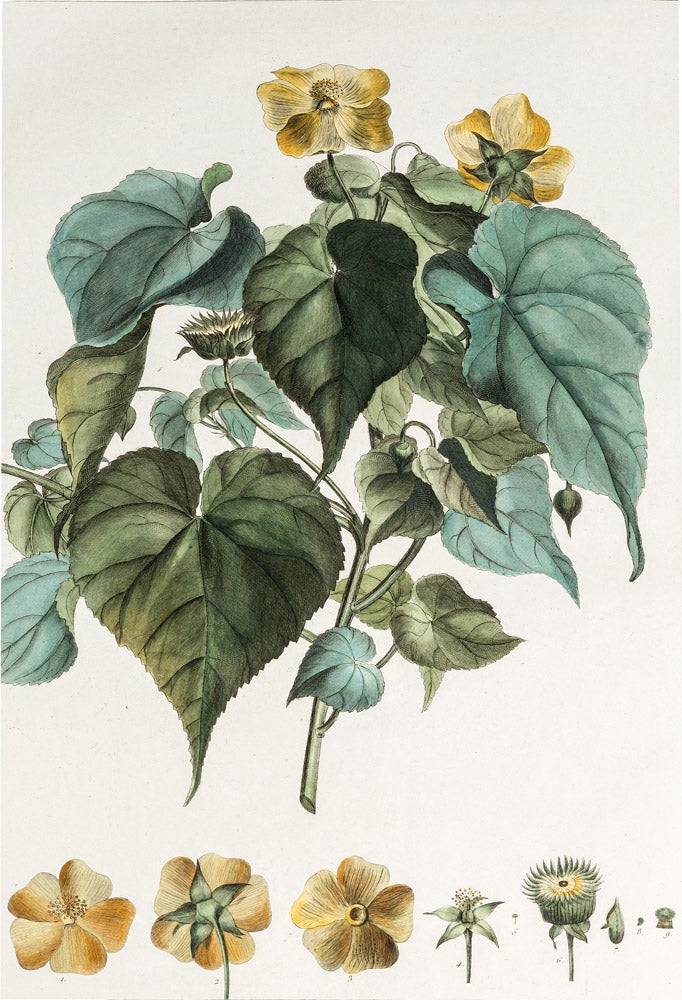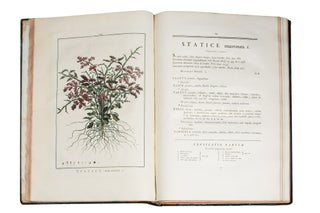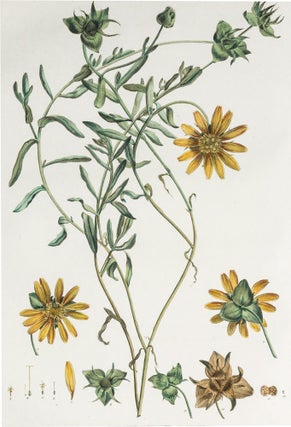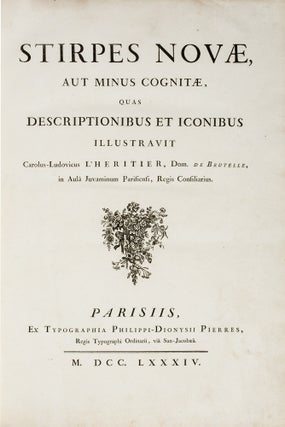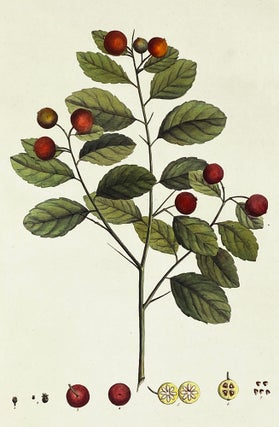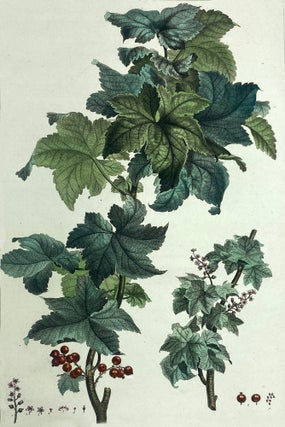Stirpes Novæ, aut minus cognitæ…
Stirpes Novæ, aut minus cognitæ, quas descriptionibus et iconibus illustravit.
Paris: Paris Philip-Dionysius Pieres (part-titles add: sold by Louis-Nicolas Prevost, Paris; Peter Elmsley, London; and Rudolph Gräffer, Vienna and Leipzig), 1784-1791.
6 parts in 1 volume, folio, (510 x 355 mm); with a general title-page, six part-titles (each with one or two woodcut vignettes) and 91 engraved plates (two double-page): 54 after Pierre Joseph Redouté, 26 after Freret, two after Prevost, two after Fossier, two after Jossigny, one after Aubriet, one after Sowerby, two after Bruguière and one anonymous, all in very good hand-colouring, protected by tissue guards; 19th-century green half sheepskin.
The first book with engravings after Redouté: with 91 hand-coloured botanical plates
A superb copy with hand-colouring: a ground-breaking work of botany, this was the first significant work with engravings by the greatest botanical artist of the age, Pierre-Joseph Redouté. The book was originally planned to comprise two volumes, but only the first six fascicles were published (the present copy includes a leaf announcing the seventh fascicle). Issued with black-and-white plates, the present copy is distinguished by having fine early handcolouring throughout.
A superb copy with hand-colouring: a ground-breaking work of botany, this was the first significant work with engravings by the greatest botanical artist of the age, Pierre-Joseph Redouté. The book was originally planned to comprise two volumes, but only the first six fascicles were published (the present copy includes a leaf announcing the seventh fascicle). Issued with black-and-white plates, the present copy is distinguished by having fine early handcolouring throughout.
'This is one of the more delightful flower books of the eighteenth century. L'Héritier de Brutelle was an amateur botanist of unusual abilities and resources. Luckily, he persuaded the young Redouté to make fifty-four drawings for his 'magnum opus'. The book is splendid in its spacious descriptions, its charming exotic plates, its implications for taxonomic history; and fascinating as an imposing piece of eighteenth-century bookmaking, with its series of fascicles printed on broadsheets, its bibliographical algebra. It is in 'Stirpes novae' that Luxemburg-born Pierre Joseph Redouté (1759-1840) emerges as an extraordinary botanical artist. He had the great good luck to have the very
fine Dutch artist Gerrit van Spaëndonck (1746-1822) as his master in drawing, and L'Héritier de Brutelle as his instructor in 'choses botaniques'"'(Hunt). Although the author had planned to publish more parts (with at least 120 plates), no further parts appeared and this fine botanical rarity is complete as published.
Charles Louis L'Héritier de Brutelle (1746-1800) was a self-taught French botanist who held several official positions; he corresponded with Joseph Banks and visited London several times, using the resources of the library at Soho Square and the gardens at Kew to write his two major books, the present work Stirpes Novæ (basically "new species") and his Sertum Anglicum (1788).
Through his connection with Banks, it was L'Héritier who wrote the first scientific description of the Eucalyptus, based on a specimen collected by David Nelson on Cook's third voyage. Here he publishes an impressive range of exotic plants from the new worlds, including a large number collected by Joseph Dombey in South America, as well as many African and Indian Ocean plants, with dozens from the Cape of Good Hope and three from Mauritius sent to France by Bougainville's old shipmate Commerson. While the inclusion of plants from French gardens and botanists is to be expected in such a work, there is also an important group from the personal collection of Banks, most having been collected by Francis Masson, the private plant hunter sent out by Banks to South Africa on Cook's Resolution in 1772, and later a formidable collector in the Atlantic and central America. One plant, the Rhodora canadensis (Newfoundland) is specifically recorded by L'Héritier as from Banks personally.
Although L'Héritier was initially embraced by the revolutionary government in France, successfully serving under both the ancien régime and the revolutionary government, most significantly as a senior environmental advisor (he was a royal superintendent for forests and waters in the Parisian region), like many of his colleagues he was lucky to survive the excesses of the Terror and seems to have inspired bitter enmity from his political rivals: he was assassinated on 18 August 1800, and the case has never been solved.
Redouté's friendship with him proved a determining factor in the great botanical artist's career and enabled him to fully develop his extraordinary talents.
Their superb collaboration here combined priority of description with new standards in engraving and book design: the elegant illustrations and the unusually fine letterpress created a model that would be much emulated over ensuing decades, not least through the direct influence of Redouté himself. It has been described as "one of the more delightful flower books of the eighteenth century" by a "botanist of unusual abilities and resources" (Hunt).
'Charles-Louis L'Heritier de Brutelle (1746-1800) was a French aristocrat, a magistrate and an amateur botanist - a Linnaean disciple, who espoused the principles of the Revolution of 1789. He was assassinated, by unknown assailant or assailants, with a sabre, not far from his house, on 16 August 1800. He was a staunch Linnaean and therefore increasingly at odds with the temple of the opposing natural system, based on overall similarity, the jardin du roi, in Paris. He was introduced to Banks by his friend the French naturalist Pierre-Marie-Auguste Broussonet (1761-1807) in 1783 and explained his plan to produce what would be his first botanical book. Stirpes novae. The first part of the work was published in March 1785, but it was never completed, as it was overtaken by the events of the Revolution. The second fascicle [sic, actually more] had plates by the Belgian-born Pierre-Joseph Redouté (1759-1840), whom L'Heritier had 'discovered' in about 1784 and trained as a botanical artist.
James Sowerby (1757-1822) also prepared one plate. L'Heritier was the first to employ Sowerby, who was then earning a living by teaching drawing and painting portraits, and taught him to draw botanical subjects, leading to a life - and a dynasty - of natural history illustration' (Mabberley, Botanical Revelation, p. 69).
It was Charles L'Héritier who described the genus Eucalyptus and named the first eucalypt specimen, Eucalyptus oblique, in 1788. This specimen had been collected in Tasmania by botanist David Nelson on Cook's third expedition in 1777 and brought to Kew Gardens, London, where L'Héritier was working at the time. L'Héritier coined the generic name Eucalyptus from the Greek roots eu and calyptos, meaning 'well' and 'covered', in reference to the operculum of the flower bud. In 1788, L'Héritier's Sertum Anglicum was published in Paris. This work included the description of Eucalyptus obliqua. L'Héritier left a herbarium of approximately 8,000 species and a large botanic library which were added to the French national collections.
De Belder, 215; Cat. Redouteana, 1; Dunthorne, 246; Great Flower Books, pp. 64-65; Hunt, 673; Johnston, 555; Nissen, BBI 1190; Pritzel, 5268; Stafleu & Cowan, 4484; cf. Buchheim, "A bibliographical account of L'Héritier's 'Stirpes novae'", in: Huntia, vol. 2, (1965), pp. 29-58.
Condition Report: Text and full-page plates printed on unwatermarked laid paper; paper of the 2 double-page plates watermarked: "IHS = DFC"; tissue guards watermarked: "J Watt & C<sup>o</sup> Patent Copying", the paper especially made for James Watt's famous copying machine, patented in 1780. [2], VI, 1-20, [2], [1] "VIII", 21-40, [2], [1], "X", 41-62, [2] "XI-XII", 63-102, [2], "XIII"-"XIV", 103-110, "109 bis" - "110 bis", 111-112, 111-112 bis, 113-118, 117 bis-118 bis, 119-120, 119 bis-120 bis, 121-134, [2], "XV-XVI", 135-184 pp.
Price (AUD): $62,000.00
US$40,346.63 Other currencies


